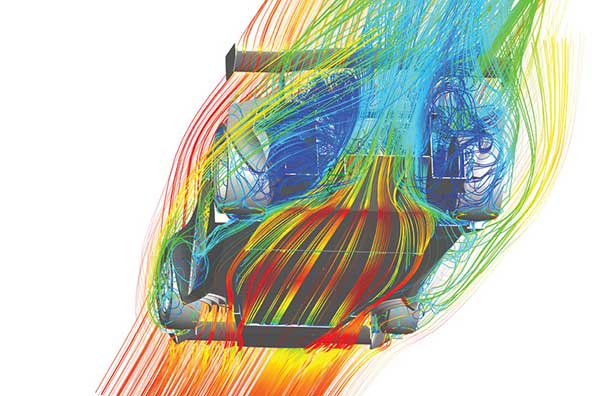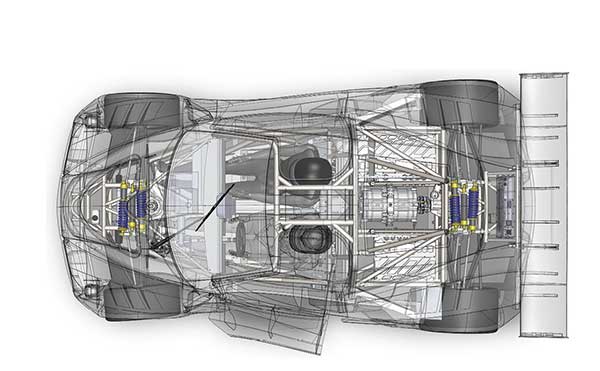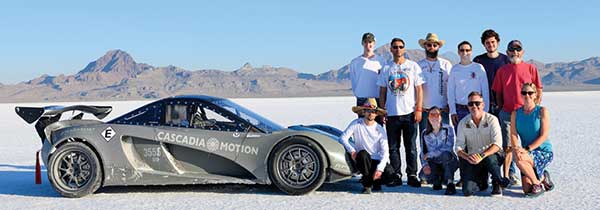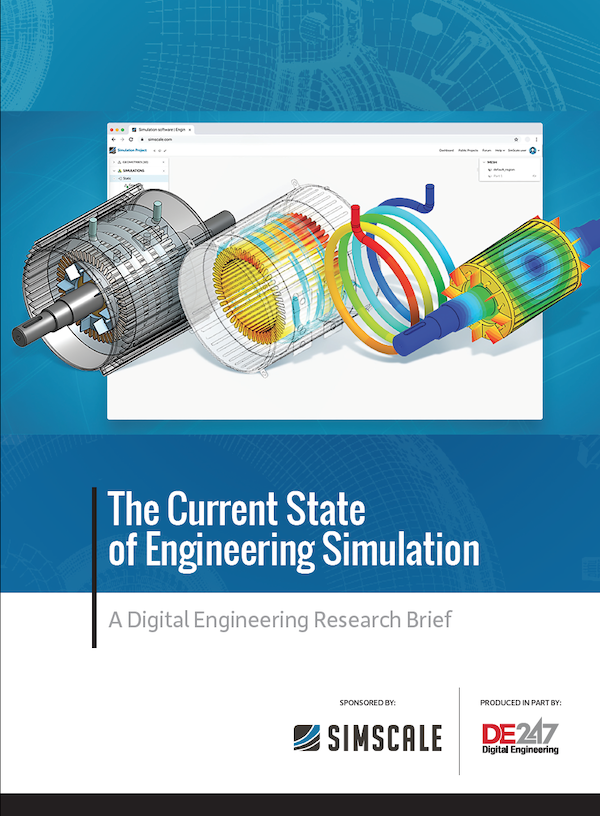
Computational fluid dynamics (CFD) software, as shown here in this screen grab from SolidWorks Flow Simulation, is an invaluable tool for designers of automobiles, aircraft and other aerodynamic products. All images courtesy of Palatov Motorsports.
Latest News
July 31, 2020
Imagine driving 12.42 miles up a steep mountain road. The average speed is nearly 100 mph, there are 156 turns to navigate and you have to reach the 14,115-foot summit in less than 10 minutes. Plus, there could be some snow and hail involved. This is no computer-generated simulation, even though it’s simulation software—in this case, SolidWorks Flow Simulation—that makes such feats possible.
The scenario just described is the Pikes Peak International Hill Climb in Colorado. Palatov Motorsport LLC has competed since 2012, when owner Dennis Palatov first set his sights on winning the annual competition with the company’s cars. In five years of running, he and his team have achieved six podium finishes, including two class wins, and have no plans to take their foot off the gas; thanks to a recent hardware upgrade, their job is about to become a bit easier.
From Computers to Cars
Palatov first began building cars in 2008, after deciding to pursue a desire he’s had since boyhood by opening the Portland, OR-based company.
“I started drawing cars at five years old, and have always been interested in building them, so after semi-retiring from a career in computer engineering, I figured it was time to chase the dream,” he laughed. “I’m all in now, and it’s the most rewarding thing I’ve ever done.”
His race cars range from the modestly priced, 900-lb., 185-hp Palatov D4, designed for “track-day enthusiasts” to the surprisingly street-legal D5, a 1,000-hp, four-wheel drive supercar for deep-pocketed buyers (the MSRP starts at $300,000). Others include the D1 and D1 PPS (Pikes Peak Special), the two-seat D2 and a host of machined suspension components and motorcycle parts, all available on the company’s website.
Palatov will tell you that designing cars from the ground up is no easy task. Each contains thousands of parts, many of them custom, all of which must fit precisely together and function without failure at white-knuckled speeds. The stakes are high, and if the driver is to win the race, the vehicle must also be aerodynamic but able to hug the ground—a factor called downforce—to avoid becoming airborne.

All of this requires capable software, Palatov noted, which is why he has relied on SolidWorks together with its full-featured computational fluid dynamics (CFD) solution since before their first Pikes Peak competition.
“I like SolidWorks because it functions the way my brain does,” he says. “It’s all parametric, so you can get the design intent down without worrying too much about the details, then tweak the numbers afterwards until everything works together.”
Slowing on the Curves
Modeling individual components or even an assembled race car is one thing; simulating its performance at extreme velocities is another. Palatov explained that, until recently, each CFD run took 12 hours or more, during which his workstation—an Intel Core i7 processor with AMD Radeon Pro WX 7100 graphics—was unusable for other tasks.
“It was fine for SolidWorks, but bogged down so much during CFD that I was limited to running it at night, after I’d gone home,” he says. “And because the CFD process is very incremental, you have to be disciplined. So you’ll change one thing during the day, rerun it that night and learn what effect it had the next morning. Depending on the number of parameters I had to adjust, it was taking weeks and sometimes months to optimize a design.”
That all changed. After speaking to a colleague, he opted to upgrade his workstation, switching to a 16-core AMD Ryzen 3950X processor and AMD Radeon Pro W5500 graphics. Palatov is now able to run CFD simulations in the background and continue to work during the day.
“I’ll still run it at night, but the new setup has basically tripled or even quadrupled my throughput,” he says. “It’s also a lot more pleasant to use. I can pan and zoom without any lag at all, and it allows me to focus on the task at hand instead of figuring out how to see what you need to see. In fact, there’s another new project that I’m working on right now where I’ve made huge progress because of the upgrade. So the return on investment has practically been immediate.”
Dialing In
Aside from enhanced productivity and usability, the new graphics processing unit opens additional doors. When Palatov first started with CFD simulations, he rented an airstrip and test-drove a car equipped with strain gauges and similar instrumentation. He then took that data and modeled it in SolidWorks.
After repeated iterations, he was able to make the simulations correlate “almost perfectly” with real life. The mesh settings and other parameters have remained static since then, Palatov says, and although he has no plans to revisit that lengthy setup process, he admits it’s a possibility.

“It was a steep learning curve,” he says. “It took us a long time to figure out which parameters matter most and how to set them. That’s the biggest trade-off with CFD, because it’s always a balancing act between simulation precision and available compute time, memory and graphics capabilities, but at the same time, you need enough resolution to actually have meaningful results.”
Palatov says that his current CFD parameter settings are tuned quite well to the cars they build and the types of surfaces they generate, but there are limitations. It won’t pick up small vortex generators, for example, although he was quick to note that these have a fairly insignificant effect on vehicle performance. Still, given the computing resources they now have available, he suggested they could probably adjust the mesh to simulate details like that, even though it would mean validating the results all over again.
“We haven’t really had the opportunity or even the need to tackle that,” he adds. “What I really like about the SolidWorks Flow Simulation, in particular, is that it does adaptive meshing, which means that it actually refines the mesh based on local flow conditions. Normally in CFD, meshes are one of the biggest challenges, and if you get this part wrong then the results are worthless. In other tools, you usually have to set mesh types for the various regions manually, a task that’s very labor-intensive and requires a high level of skill. But SolidWorks does an excellent job of doing that automatically. It’s a huge time-saver.”
Subscribe to our FREE magazine, FREE email newsletters or both!
Latest News
About the Author
Kip Hanson writes about all things manufacturing. You can reach him at .(JavaScript must be enabled to view this email address).
Follow DE




